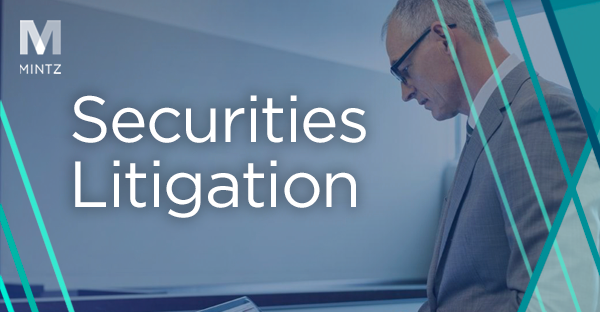Second Circuit Clarifies the Circumstances in Which Presumptions Can Be Used To Support Federal Securities Fraud Class Action Lawsuits
On August 10, 2023, the U.S. Court of Appeals for the Second Circuit took an important step in Arkansas Teacher Retirement System v. Goldman Sachs Group toward clarifying the circumstances in which federal class action plaintiffs can – and cannot – rely on mere presumptions to proceed to the merits phases of logically weak securities fraud cases.
Typically, when a company’s stock price drops as a result of bad news, securities plaintiffs’ lawyers look to see what, if anything, the company previously disclosed about the subject – searching for a misstatement or arguably misleading omission that might serve as the basis for a lawsuit to recover some of the lost value, on the theory that fraudulently-induced market misunderstandings previously inflated the stock’s price, which fell to its “correct” value only after the “truth” revealed by the news became known.
While it would be practically impossible to base a common law fraud class action on such an earlier misstatement or omission – because only investors who actually read the prior materials could satisfy the “reliance” element of a fraud claim and be eligible to participate – in 1988 the Supreme Court ruled in Basic v. Levinson that investors seeking to recover losses under Section 10(b) of the federal Securities Exchange Act can invoke a presumption of reliance based on a “fraud-on-the-market” theory where: (i) the alleged misrepresentation was publicly known; (ii) the misrepresentation was material, and (iii) the company’s stock traded in an efficient market such as a major stock exchange. The fraud-on-the-market theory presumes that the impact of alleged misrepresentations – and all other publicly-known information – is, in essence, “baked into” a stock’s price and, thereby, indirectly relied-on by all investors.
While Basic’s presumptions might be justified in a situation where a company is alleged to have made affirmatively false statements (concerning, for example, its financial situation or results of operations), defendants have long argued that such presumptions are unjustified where plaintiffs rely on supposedly misleading omissions to support their case – or on statements issued at such a high level of generality that it is difficult to imagine investors basing actual investment decisions on them. (For Basic’s presumptions to make sense, a misstatement or omission must actually be significant enough to prop up a stock’s price – and by roughly the same amount as its eventual drop.)
That is the situation in which Goldman Sachs found itself in 2010, when the company’s stock price fell after the SEC announced that it was initiating an enforcement action alleging that Goldman improperly marketed investments in a privately-offered collateralized debt obligation vehicle called Abacus 2007 AC-1 without disclosing that a hedge fund that helped select assets for the vehicle was at the same time shorting those assets. Not surprisingly, plaintiffs could point to no previous public statements about Abacus as being misleading, because Goldman had not previously discussed it publicly at all. Nevertheless, a group of plaintiffs sued the company for federal securities fraud, alleging that generalized public statements like “Our clients’ interests always come first” and “We have extensive procedures and controls that are designed to identify and address conflicts of interest, including those designed to prevent the improper sharing of information among our businesses” were actionably misleading because they omitted to note that Goldman nonetheless was allegedly mismanaging certain conflicts.
In the years following Basic, courts had acknowledged that it established only a presumption of reliance that defendants should be permitted to rebut before a class is certified by presenting evidence that any alleged misstatements or omissions did not, in fact, artificially inflate its stock price. How, exactly, a defendant could do so was left largely unexplained, however – and conceptually difficult, since whether an alleged misstatement or omission is material (i.e., likely to affect a reasonable investor’s decisions) has been deemed a “merits” question not appropriately decided at the class certification stage of a case.
In Arkansas Teacher Retirement System, Goldman attempted to rebut the presumption of price impact / reliance by presenting expert reports showing that: (i) on 36 dates prior to the allegedly “corrective” news about the SEC action, media outlets discussed transactions that raised questions about Goldman’s ability to manage conflicts of interest but the company’s stock price did not decrease on any of those dates (leading to the inference that the company’s stock price eventually dropped not because investors learned that Goldman’s prior statements about possessing conflicts procedures and placing its clients’ interests first were false, but because investors were concerned about the consequences of the newly-disclosed SEC proceeding); and (ii) in none of the 880 analyst reports issued about Goldman between the time it first discussed its conflicts procedures and the time the SEC enforcement action was announced was there any discussion of the company’s conflicts management statements (leading to the inference that those statements played no role in supporting Goldman’s stock price throughout the period, while issues actually discussed in the analyst reports might very well have).
The district court found those showings unconvincing, however – or altogether irrelevant, because they went to the issue of materiality, rather than reliance. Goldman appealed to the Second Circuit and, in 2021, all the way to the Supreme Court.
As we’ve discussed in a prior post here, the Supreme Court ruled that certainty is not required when deciding whether to certify a class based on a Basic presumption; “[t]he district court’s task is simply to assess all of the evidence of price impact – direct and indirect – and determine whether it is more likely than not that the alleged misrepresentations had a price impact. That is so regardless of whether the evidence is also relevant to a merits question like materiality.” In doing so, “courts ‘should be open to all probative evidence on that question – qualitative as well as quantitative – aided by a good dose of common sense.’”
In remanding for a new analysis to be done, the Supreme Court pointedly explained that, “[t]he generic nature of a misrepresentation will be important evidence of a lack of price impact, particularly in cases proceeding under [an] inflation-maintenance theory. Under that theory [plaintiffs typically] point to a negative disclosure about a company and an associated drop in its stock price; allege that the disclosure corrected an earlier misrepresentation; and then claim that the price drop is equal to the amount of inflation maintained by the earlier misrepresentation. But that final inference – that the back-end price drop equals front-end inflation – starts to break down when there is a mismatch between the contents of the misrepresentation and the corrective disclosure. That may occur when the earlier misrepresentation is generic (e.g., “we have faith in our business model”) and the later corrective disclosure is specific (e.g., “our fourth quarter earnings did not meet expectations”). Under those circumstances, it is less likely that the specific disclosure actually corrected the generic misrepresentation, which means that there is less reason to infer front-end price inflation – that is, price impact – from the back-end price drop.”
Notwithstanding the Supreme Court’s commentary, on remand the district court again decided to permit the plaintiffs to proceed past class certification, finding that Goldman’s statement that it had extensive procedures and controls designed to identify and address conflicts of interest was sufficiently “non-generic” to support a claim, the 36 prior disclosures of potential conflicts identified by Goldman’s experts were less significant that the “corrective” Abacus disclosure, and the 880 analyst reports that never mentioned Goldman’s conflicts disclosures were not in themselves compelling – even if they did suggest that Goldman’s compliance “statements were [not] consciously relied upon, in the moment, by investors evaluating Goldman.”
In its August 10, 2023 opinion on appeal from that decision, the Second Circuit ruled that the district court erred both as a matter of fact and of law. As the Second Circuit explained, if Goldman’s conflicts-related compliance statements were never consciously relied upon, “how, then, can it be that the statement[s] impacted Goldman’s stock price?” While the district court seemed to believe that Goldman’s stock price would have dropped if the company had disclosed the alleged Abacus conflict of interest at the time it generically announced its conflicts compliance procedures, the Second Circuit held that it was legally improper to ask what would have happened if the actual, specific, “corrective” disclosure was made earlier: the Supreme Court’s pointed discussion of the generic nature of certain disclosures indicates that courts should concern themselves only with what would have happened if a defendant earlier spoke truthfully at the same level of generality that it actually did. In the Second Circuit’s view, the 880 analyst reports giving no heed to Goldman’s statement that its compliance procedures address conflicts of interest made it unlikely that an allegedly more truthful but equally generic statement would have impacted Goldman’s stock price.
The Second Circuit’s decision is important not only because it has now given defendants a helpful example of how they might rebut the presumptions articulated in Basic v. Levinson, but also because it has expressly reminded courts that Basic’s presumptions can and should be questioned where, as in the Goldman case: “(1) there is a considerable gap in front-end and back-end genericness [in the defendants’ alleged statements]; (2) the corrective disclosure did not directly refer … to the [first] alleged misstatement, and (3) the plaintiff claims, as plaintiffs claim here, that a company’s generic … disclosure was misleading by omission.” We anticipate that the Goldman decision will be cited in many, many putative securities fraud cases to come and serve as a valuable precedent for issuers seeking to defeat a motion for class certification.



